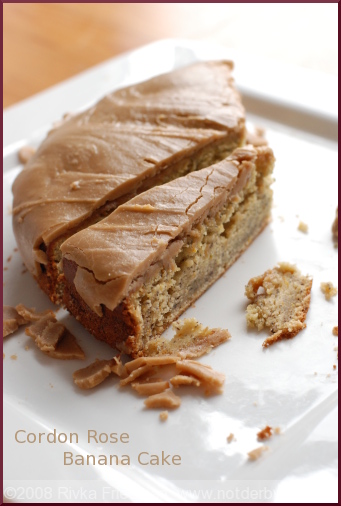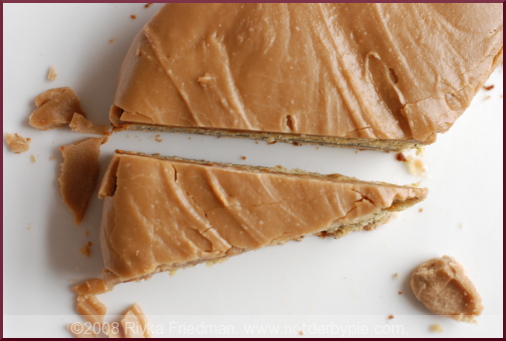When I was a kid, my dad ate bananas a lot. He bought them when they were green, ate them when they were yellow and even when they had lots of brown spots, and when the rest of us finally managed to convince him that the last of the bunch was really way to overripe to eat, he’d freeze it until he had enough to make banana bread. My mom, clearly the more sane parent in this respect, ate bananas only when they were green. Yes, that’s right — totally and completely underripe. Once they were yellow, they were banana bread to her.
If I remember correctly, my brother ate bananas when they were yellow, and if pushed, he’d begrudgingly eat one with a couple spots, but he drew the line way before my dad did. And I? No, I don’t eat bananas. Never liked’em. Just not really my thing. No surprise, then, that I’ve never really associated bananas with elegance or delicacy. Before this weekend, I’d have been hard pressed to believe that a couple bananas could produce not only your usual dense and very banana-y banana bread, but a moist and rich, yet light and delicate, cake as well.

I owe Mandy for this discovery. When D and I went over to the Masseys for dinner a few weeks ago, Mandy served a banana cake for dessert. The kids raved about the cake all evening — “ohhh my gosh, it’s just soooo good, you’ll lovvvve it!” Ever the skeptic, I nodded, smiled, and said, “D, you must be so excited — banana cake” while planning to politely request just a sliver for myself.
But you know me too well! I never pass up dessert. Not even banana-flavored dessert. And in this case, my bigger-than-stomach eyes served my mouth oh, so well. Tasting much more mildly of banana and wonderfully tart from sour cream and lemon zest, the Cordon Rose Banana Cake couldn’t be further from run-of-the-mill banana bread. It’s seriously delicate — confusingly delicate, considering its main ingredient — and very fragrant, from both the zest and a healthy dose of vanilla.
But that’s not the end. In a stroke of genius, Mandy iced the cake with a quick caramel frosting. The frosting has lots of confectioners’ sugar in it, so it’s poured over the cake while still warm. As it solidifies, it develops a nice thin crust. The caramel is truly a perfect topping to this cake — especially lovely if you use half salted butter in it. However, for all you purists out there, here’s something I thought I’d never say: Cordon Rose Banana Cake is fantastic, absolutely fantastic, all by itself.
Cordon Rose Banana Cake
From Rose Levy Beranbaum’s The Cake Bible
For the cake:
2 cups sifted cake flour
¾ cup plus 2 Tbs sugar (I used fine-grained unrefined cane sugar, which worked fine)
1 tsp baking soda
¾ tsp baking powder
½ tsp salt
2 large ripe bananas (about 225 grams, peeled)
½ cup sour cream (not low- or non-fat)
2 large eggs
1 ½ tsp pure vanilla extract
10 Tbs unsalted butter, at room temperature
2 tsp grated lemon zest (orange zest will also work)
For the frosting:
1 stick salted butter (if using unsalted, add 1/2 tsp of salt)
1/2 cup packed light brown sugar
1/2 cup packed dark brown sugar
1/4 cup whole milk
2 cups confectioners sugar, must be sifted!
1 tsp. vanilla
Preheat the oven to 350 degrees Fahrenheit. Spray a 9-inch round springform pan with cooking spray, line the base with a round of parchment paper, and spray the parchment paper.
In a large bowl, whisk together the flour, sugar, baking soda, baking powder, and salt. Set aside.
In a food processor, purée the banana and sour cream until completely smooth. Add the eggs and vanilla, and process briefly to combine. The puréed mixture will be light yellow and quite loose.
Add the softened butter and about ½ of the puréed mixture to the dry ingredients in the bowl. Beat to combine on low speed; then increase the speed and beat for about 90 seconds to aerate the cake structure. Scrape down the sides of the bowl with a rubber spatula, and add the rest of the purée, beating to combine well. The batter will be light tan in color and should be smooth and creamy.
Pour and scrape the batter into the prepared pan. Bake for 35-45 minutes, until the cake is golden and a toothpick inserted in the center comes out clean and dry. Remove the cake from the oven, let cool for 10 minutes while you make the frosting (below), and then remove the rim of the pan. Invert the cake onto a wire rack, and carefully remove the base of the pan and the parchment paper. Turn onto a cake platter.
For the frosting:
Heat butter and brown sugars over medium until the mixture comes to a boil about 2 minutes. Add the milk, stir, and bring the mixture back to a boil, then remove the pan from the heat. Add the confectioners’ sugar and vanilla. Beat with a wooden spoon or whisk until smooth. Use immediately, while it and cake are still warm, and spread quickly before cool.
Allow the cake to sit at room temperature for at least a half hour before serving.


Comments on this entry are closed.
The frosting is a stroke of genius! How simple, pretty and perfect with bananas. I am not even a fan a bananas but I would love a bite of this cake -an end piece, with lots of frosting.
I’m very excited about this recipe. The one time I tried banana bread it was overcooked on the top and sides and raw in the middle. 🙁 I needed another recipe for my too ripe bananas. Thanks, this looks like just the thing. I’ve printed ou the recipe. (love your print button!)
BTW, your photos look DELISH!
~ingrid
Awesome! I was just wondering about what to use as a topping for banana bread. I made some yesterday and had no idea what to top it with–I wasn’t interested in cream cheese frosting and I was bored leaving it plain. I ended up using a lemon-sugar-coconut glaze, which was nice, but not the best. This caramel frosting looks perfect! Thank you for posting it.
I’m also not a banana fan (I thought I was the only person in the world) but you’ve actually talked me into saving this recipe… and that frosting looks to die for. I’d love anything covered in that XD.
Is there anything similar that is parve? Looks really good…
Rivka, your tantalizing photos do honor to this recipe. I especially love the way your camera makes a virtue of the icing’s occasional crumbling and “chipping” from the side of the cake.
I wanted to add a couple notes to your faithful rendering of the recipe:
***If you’re out of sour cream, yogurt works as a substitute.
***I’m usually too lazy for the recommended puree step — fork mashing does just as well.
***Because I tend to burn stuff on the stovetop (usually while reading a magazine), I melt my icing ingredients in a double boiler; never burns.
***Also, I know you made the icing without sifting the confectioner’s sugar. As we’ve discussed, I never bother to sift flour (though I do whisk dry ingredients to mix), but I find sifting a must to get a smooth frosting. Will you clue us into your trick to avoiding lumps?
Simon — good question! I really struggle to make pareve desserts. I think my suggestion would probably be to eliminate the butter, and use earth balance (soy-based cooking-safe pareve butter substitute) instead, though you’d sacrifice on taste for certain. let me know if you think of anything!
Mandy — thanks for adding all the tips! It’s true that I don’t sift my powdered sugar. To my mind, there are two alternative methods: the first is to mix the powdered sugar in a separate bowl with enough of the milk mixture to form a paste, which prevents clumping, and then add that back into the milk. The second is to do as the recipe instructs, but to stir for quite a long time until the lumps slowly disappear. The second way works — I do it all the time — but the first way is more fool-proof.
I’ve made this cake twice and it’s the best. But am I blind, or is lemon zest listed as an ingredient but not in the instructions?
My mother used to make a banana cake with a lemon-vanilla frosting…fabulous combination, too.